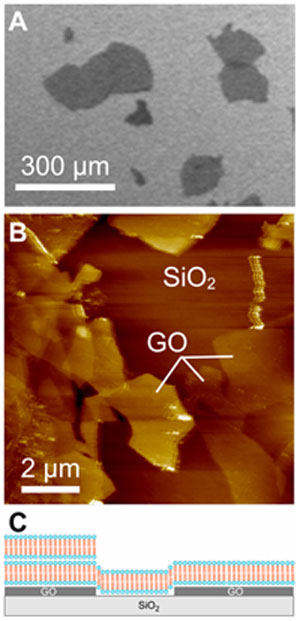| Mar 17, 2012 |
Graphene shows potential for modelling cell membrane systems
|
|
(Nanowerk News) The intriguing properties of graphene—a single atomic-layer of carbon—such as high electron mobility and fluorescence quenching are being exploited for biosensing and analysis of nucleotides, peptides, and proteins.
|
|
Graphene could also play an important role in the modelling of cell membranes. For example, the lipid bilayer is the fundamental structure of cell membranes, and the structure and dynamic of bilayer membranes govern the transport of materials and information in and out of cells.
|
 |
| Fig.1. (A) Scanning electron microscope image of GO flakes dropped onto a SiO2/Si substrate. (B) Atomic force microscope topography and (C) structural model of DOPC bilayer membranes on GO/SiO2/Si.
|
|
Ryugo Tero and his colleagues in the Graphene Research Group at Toyohashi University of Technology have established a new procedure to fabricate artificial planar lipid membranes on graphene oxide (GO) and reduced graphene oxide (r-GO) as a means of detecting biomolecules such as lipids and proteins on and inside lipid bilayers (see paper in Journal of Physics: Conference Series: "Fabrication of Supported Lipid Bilayer on Graphene Oxide").
|
|
An aqueous solution of GO was prepared by chemical exfoliation and dropped onto a thermally oxidized and cleaned SiO2/Si substrate (Fig.1A). The resulting GO/SiO2/Si was incubated in a vesicle suspension of phospholipid (dioleoylphosphatidylcholine: DOPC). Subsequent observation with an atomic force fluorescence microscopy (Fig.1B) and revealed the presence of two planar DOPC bilayer membranes stacked on GO with the assistance of calcium ion (5 mM), and that the DOPC bilayers on GO were fluid and continuous with the surrounding DOPC bilayers on the bare SiO2 surfaces (Fig. 1C).
|
|
Lipid bilayer/monolayer stacking structures were obtained on hydrophobic r-GO, which was produced by reducing GO with hydrazine vapour. Artificial lipid bilayers on graphene and its derivatives could be a new cell membrane model system for the researche on fundamental processes in cell membrane reactions.
|
|
|

